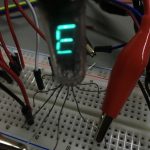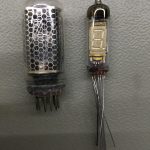What is a VFD tube ?

I got my hands on four IV-3A VFD tubes. When I started to learn about these tubes, I called them “Nixie tubes”, but that is wrong, very wrong. The more I learned about VFD tubes, the less I called them “Nixie tubes”.
So what is a VFD tube ? Well, VFD stands for: “Vacuum Fluorescent Display” And that is the first big difference with a Nixie tube. A Nixie tube is NOT a vacuum tube, a Nixie tube is filled with a gas (neon gas).
A lot of information on how a VFD tube works, can be found online (and Nixie tubes as well of course). According to Wikipedia:
A VFD operates on the principle of cathodoluminescence, roughly similar to a cathode ray tube, but operating at much lower voltages. Each tube in a VFD has a phosphor coated anode that is bombarded by electrons emitted from the cathode filament.[1] In fact, each tube in a VFD is a triode vacuum tube because it also has a mesh control grid
For more info see: Vacuum fluorescent display
A VFD tube is not a Nixie tube

Often I see a VFD display are sold/advertised as being a “Nixie tube” However a VFD display is not a Nixie tube. Compared to a Nixie tube, the Nixie tube has “stacked numbers” (cathodes). And a wire-mesh of anodes. And each number lights up when a high voltage is applied to one of the cathodes.
A Nixie tube works with voltages above 100 Volts (around 180 Volts). A VFD tubes needs multiple voltages for the heater, grid and the segments. The heater voltages are usually around 1V, and the grid and segments are in the range of 20 – 30 Volts.
So a VFD works with much lower voltages then a Nixie tube.
Another difference between a VFD and a Nixie tube is that a VFD is a vacuum tube, whereas a Nixie tube is filled with a neon gass.
Getting the IV-3A tube to work
It took a lot of searching to find information about the IV-3A tube. Since these tubes where produced in Russia, the datasheets for the tubes are also in Russian. And I don’t speak, and cannot read Russian. I did found some info, for instance on the EEVBLOG Forum, where I found the voltages and Amperes needed for the heater. But I could not find information about the pin-out of the IV-3A tube. What I could find, is that the pin-out is the same as the IV-6 VFD tube.
A good friend of mine, Dave gave me an excellent tip: to use the Google translate app, and scan the PDF with my phone’s camera. This worked to some extend. The translation was not perfect, but gave me the last pieces of information I needed to get the IV-3A tube working.
The technical specs of the IV-3A tube
The IV-3A tubes needs the following voltages:
- Heating voltage: 0,7 … 1 V
- Grid voltage: 20 … 30 V
- Anode-segments voltage: 20 … 30 V
- Current of heating: 25 … 35 mA
- Grid current: no more than 12 mA
- Current of the anodes-segments: no more than 0.45 mA
- Readiness time: not more than 0.2 s;
The pinout of the IV3A is simple: There is a wire cut off. This wire also has no internal connections. This wire is the “index wire” This is pin 12. Pins 7 and 8 are the heather (cathode). One of these pins must be connected to gnd, and the other pin must be connected to a positive voltage (0.7 .. 1V).
Pin 9 is the grid pin, this pin must be connected to 20 .. 30V. The rest of the pins are the different segments (so pins 1,2,3,4,5,6,10,11) When these pins are connected to 20..30V a segment lights up. When a segment pin is connected to GND, the segment is “off”.
So to connect the IV3-A tube, and to test if all segments work, connect pin 7 to gnd, and pin 8 to +0.7V. Next connect pins 1,2,3,4,5,6,10,11 and pin 9 to +20V (don’t apply the max voltage of 30V to long, this will shorten the life of the tube). If the tube is working you should see all the segments lit.
See the datasheet of the IV-3A here (this PDF is part of Dieter’s Nixie- and display tubes data archive datasheet of the IV-3A
This is everything I’ve been looking for!!!
Thank you!
Your welcome 🙂 I’m glad I could help you by writing this article
Great info, thanks!
thank you for this feedback 🙂
Hello,
there is one more magic here. There are IV3-v82 which have pins like IV3A (9 segments), but they are 7 segments (3 pins are cut). Please check the link:
https://timewitharduino.blogspot.com/2017/07/iv-3-vfd-confusion.html?m=1
Thanks for this link! Hope others find it useful as well.